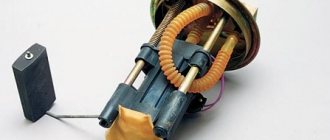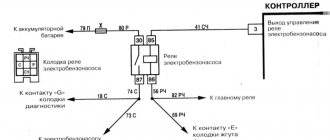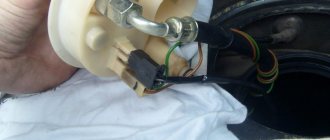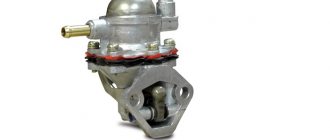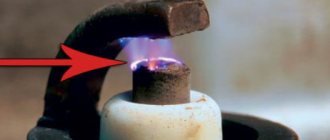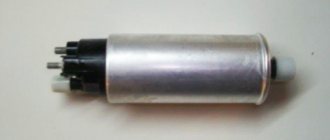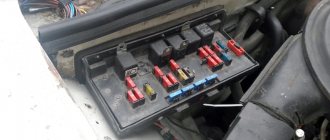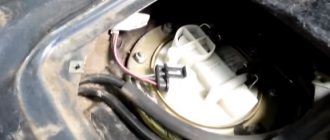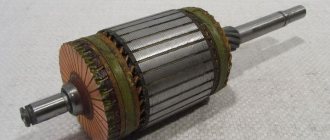The gasoline pump serves to supply fuel from the tank and maintain the pressure in the line necessary for the operation of the injectors. Interruptions in the supply of gasoline lead to a disruption in the composition of the air-fuel mixture, which leads to poor-quality combustion and misfires, the engine begins to stall, respond sluggishly to the gas pedal or stall. If the fuel pump (FP) does not pump, the engine will not start at all.
Symptoms of a fuel pump malfunction and methods for diagnosing them on an injection engine
The power systems of modern fuel-injected internal combustion engines use an electric fuel pump. Depending on the installation location, there are submersible (installed in the tank) and flow-through fuel pumps (cut into the fuel supply line).
Main components of an electric fuel pump:
- two-piece body;
- DC motor;
- pumping section.
According to its design, the section can be rotary, blade, gear or turbine type. The latter option, due to its simplicity of design, has earned the greatest popularity. The rotation of the impeller attached to the electric motor shaft creates zones of high and low pressure, due to which fuel is taken and pumped from the tank into the pipelines.
Motor power circuit
In addition to the submersible fuel pump, the fuel module located in the tank includes:
- float type fuel level indicator sensor;
- critical gasoline level sensor;
- coarse filter;
- built-in fuel pressure regulator (RDT). This type of RTD is found on returnless power systems. Another type of design involves the presence of a fuel return line and a regulator mounted in the fuel rail;
- inlet and outlet fuel lines;
- electrical connectors.
Symptoms of a worn fuel pump motor:
- uncertain engine start;
- failures when sharply pressing the accelerator pedal;
- insufficient power at high speeds;
- The engine periodically stalls and refuses to start for some time. Often in such cases, several blows to the tank help bring the fuel pump back to life.
The cause of the described symptoms is worn brushes and the electric motor commutator. When the brushes are worn out, they do not press well against the lamellas of the commutator, which is why the current in the circuit drops, which leads to a decrease in the performance of the fuel pump.
Wear of electric motor components is the most common reason why the fuel pump does not pump gasoline well.
If power comes to the connector, but fuel does not flow from the pump, the reason may be melting of the plastic housing due to overheating or critical wear of the brushes/commutator. In this case, when you turn on the ignition, you will not hear a characteristic buzzing sound from the fuel module. Sometimes a situation in which the fuel pump pumps, but no gasoline comes out, occurs due to poor fixation of the corrugation going from the pump to the outlet fittings of the fuel section. Due to the pressure created by the pump, the corrugation jumps off the fitting.
If the gas pump works but does not pump enough gasoline, first of all pay attention to the coarse and fine filters. Clogged filters can be identified by the fact that the fuel pump hums louder than usual. Please note that operation under load reduces the service life of the transformer. The cause of insufficient pressure may also be a faulty fuel pressure regulator, which discharges too much fuel into the return line.
Failure of the fuel pump due to wear of the elements of the pump section occurs only in the case of low-quality components. You are more likely to replace the fuel pump due to worn brushes than to face mechanical wear on the pump section components.
Adjusting the pressure in the fuel system
A simple way to regulate the operation of a worn-out fuel pump is to install a fuel pressure regulator. It connects to the fuel rail and shows the pressure, allowing you to change it either up or down.
The device allows you to adjust the fuel pressure in the system depending on the situation
To measure the fuel pressure in the system, you can also use a pressure gauge by connecting it to the fuel rail.
How to check the fuel pump?
The most reliable diagnostic method is to check the gasoline pressure in the fuel line.
On sale you will find ready-made kits with adapters for connecting to the most common power systems. You can build the device with your own hands from a pressure gauge with a scale of up to 6 kg/cm2, a hose, adapters and fittings. To check the pump you need:
- Relieve the residual gasoline pressure in the line.
- Connect the pressure gauge across the engine power supply system. Some cars have a standard fitting to check the performance of the pump.
- Turn on the ignition. A value of 3-4 kg/cm² is considered normal. The exact parameters for a specific engine are in the repair and operation manual.
- Start the engine. A working fuel pump creates excess pressure (about 7 kg/cm²), which is released into the tank by the regulator. Therefore, in all engine operating modes, the pressure in the ramp should not deviate significantly from the standard values. When diagnosing, try to simulate the conditions under which the symptoms of a faulty fuel pump manifest themselves most often (engine temperature, load, etc.)
If the measured value is lower than acceptable, the fuel pump on your car is faulty or the fine/coarse filter is clogged. In this case, the fuel pump heats up, which can lead to melting of the housing and burnout of the electric motor.
Design of a carburetor fuel pump VAZ 2109
To understand why the VAZ 2109 fuel pump (carburetor) does not pump, let’s briefly look at its design. So, the “nine” fuel supply device consists of:
- housings;
- pusher with mechanical pumping lever;
- diaphragm assemblies;
- covers with valves and fittings for attaching hoses;
- mesh filter;
- manual pumping lever.
Connection diagram
Fuel pump relay diagram
Above is a standard connection diagram for a fuel injection pump engine. The ECM (controller), after successfully polling the immobilizer, energizes the coil winding of the fuel pump relay (pins 85, 86). Under the influence of electromagnetic induction, power contact 30 (constant “+” from the battery, protected by fuse X) and contact 87 close, which leads to the inclusion of the fuel pump. Main faults:
- fuse blown; Attention! Replace the burnt-out fuse-link with a fuse of standard rating. Installing an insert designed for high current may result in a vehicle fire.
- formation of oxides inside the connectors, burning of the power contacts of the fuel pump relay. Parasitic resistance leads to a drop in current in the circuit and a decrease in the performance of the nose;
- chafing, breaking wires;
- breaking off the latch of the power connector going to the fuel module. Often in this case, contact is broken when driving over uneven surfaces.
Video: Fuel pump does not work. How to find and eliminate the cause.
Car won't start after replacing fuel pump
Sometimes, after installing a new pump, the car cannot be started. There may be several reasons for this problem.
A defective product has been installed. It needs to be replaced.
The fuel inlet and outlet pipes are not connected correctly.
The power plug is not connected correctly.
The terminal contacts have oxidized. They need to be cleaned.
Proper connection of wires and fuel supply pipes guarantees proper operation of the fuel pump
The fuel pump is the main element of the fuel supply system. Any malfunction leads to the impossibility of further operation of the vehicle. You should pay attention to all symptoms of decreased performance of the mechanism, immediately identify them and take appropriate measures. Good luck on the roads!
A car fuel pump is a device designed to provide an uninterrupted supply of fuel to the installation in which the fuel mixture is formed. Even the slightest malfunction leads to interruptions in the operation of the engine, and in the event of more serious problems, you simply will not start it.
In this article we will look at situations where the gas pump does not pump fuel at all, or pumps it, but not in the amount required by the power unit for normal operation. We will also try to understand the possible causes of this or that malfunction of the fuel supply device and discuss methods for eliminating them independently using the example of domestically produced cars carburetor VAZ-2109 and injection VAZ-2114.
Power check
You can establish the presence of voltage at the TN connector using a simple test to check electrical circuits. To check the fuel pump, in the electrical diagrams for your car model, find the pinout of the electrical connector of the fuel module. For the pump motor to operate, “–” and “+” are required. If, after turning on the ignition and connecting the control contacts to the corresponding pins of the block, the light comes on, then everything is in order with the supply voltage. Using this method, you can check for the presence of +12V and ground in the fuel pump relay connector, and establish the presence of supply voltage from the ECM to the relay. If the fuel pump does not turn on, but there are no problems with the components of the electrical circuit, the reason is in the fuel pump itself.
The most convenient way to determine why there is no power to the fuel pump is to use a multimeter. Let's say that + 12V to the pump comes from the relay, but does not reach the fuel module connector. In this case, it is necessary to ring the wires from the relay to the fuel section. In ohmmeter mode, you will not only find an open, but you will also be able to see the parasitic resistance in the circuit. When considering possible reasons why the fuel pump does not pump, do not forget about the immobilizer failure. Often in such cases the engine starts, but stalls after a few seconds.
Operating principle of a mechanical fuel pump
The fuel pump is driven by the camshaft cam, which moves the pusher in a horizontal direction, causing it to perform reciprocating movements. The pusher, in turn, acts on the mechanical pumping lever, and it already raises and lowers the membrane rod.
Thus, a certain pressure is created inside the fuel pump, which is maintained by the valves of the device cover. One of them lets fuel in without letting it back in, and the second pushes it into the fuel line going to the carburetor.
As you can see, the design is very simple, therefore, to determine the reason that the fuel pump does not pump, it is enough to disassemble it and check the condition of the main elements.
Start with the relay and fuse
Considering that the fuel supply module is located in the car tank, and it is not so easy to get to it, it is better to start diagnostics with the relay and fuse:
- Unscrew the screws securing the cover of the mounting block located to the left of the steering column.
- Underneath it, find fuse F3 (15 A) and relay R2. These are the elements that we need to check.
- As for the fuse, it needs to be “ringed” with a tester. If unusable, replace it.
Checking the relay in a garage is quite difficult. But you can take a similar one (from an adjacent socket), a known good relay, and install it instead of the one being diagnosed. Now turn on the ignition. Is the fuel pump pumping? The reason has been found! Well, if nothing has changed, move on.
Gasoline supply problems - common symptoms
- The combustible mixture is not supplied to the cylinders at all.
- Gasoline is supplied intermittently or under insufficient pressure.
In the first case, the engine does not start and does not engage the starter during rotation, that is, it does not show signs of life. In such a situation, it is always easier to determine the cause of the breakdown.
When insufficient fuel enters the cylinders, the following symptoms appear:
- starting the power unit “from cold” is very difficult, the engine seizes and “sneezes”, it starts in 3–10 attempts;
- idling is unstable, the engine “troubles”;
- dynamic acceleration becomes impossible - a sharp opening of the throttle causes a long dip and deceleration;
- when the driver releases the accelerator pedal, the engine often stalls;
- The car has difficulty climbing hills and accelerates slowly when fully loaded.
The cause of the above phenomena may be a malfunction of the fuel pump or other elements of the system, and the primary symptoms are almost the same. To carry out an accurate diagnosis, you need to understand how the car's power system works.
not a breeder =(
In general, it was like this: I was driving along the highway, I was staring at it and didn’t notice how I was going 40 km/h in 5th gear, suddenly the car started to twitch and stalled. I pulled over to the side of the road, started it again, and drove off. hundred meters. twitched, stalled and would not start. I turn the key, the fuel pump is silent, I thought it was dead, I took it out in the garage, checked it, it works. I looked at the fuse - it was intact, I looked at the relay - it was intact. After two evenings of garage life, the problem was found - there is no ground on the fuel pump relay, which is under the hood near the battery. Well, I thought the problem was solved, but hell. Today I threw the snot from the relay to ground, turned the ignition key, the pump started working, but it does not turn off when it pumps up the required pressure to start, and gasoline dripped from the hose near the gas filter and the car still does not start. On my knees I ask, P A M A G I T E! ! ! I've already been on foot enough in a week, I want to drive, I miss it
=(
try installing another relay, maybe it will stick
Calm, just calm, as the Great Lord of the impeller said) Actually, everything is fine with me. Now. I am writing this post so that people whose working fuel pump suddenly stops working can find it in a search. I had this problem for a long time, and I suffered for a very long time, and did not know how to eliminate the consequences of this unknown crap, while flipping through a lot of information. And so, this morning, when at minus 35 the car did not start, and I stupidly forgot about this trick, and having drained the battery I almost went to work on a minibus, I again remembered what needed to be done. I'll tell you what the point is. The fuel pump just refuses to turn on. The brain should supply a minus voltage to the fuel pump turn-on relay, but for some reason it does not supply it periodically. Either a glitch in the brain, or a bug in the signaling. But I’m not the only one, and the problem, as it turns out, visits many.
Causes and their identification
The reasons why the fuel pump does not work may be: violation of the integrity of its diaphragm, accumulation of dirt in the valve area, contamination of the filter, if the spring has lost its elasticity, the housing has become leaky, normal natural wear and tear of pump parts. Electrical malfunction occurs only when exposed to it. Now on modern cars it is quite reliable. Several can be highlighted. Faulty wiring (dirty or rusty wires can cause interruptions in operation), dirt in the tank, clogged fuel filter, frequent and long-term driving of the car with a minimum amount of fuel and, of course, the usual natural wear and tear of pump parts.
Wiring fault
To diagnose a pump in electrical systems, you will need to find the pinout of the electrical connector of the fuel module that is suitable for the car model. To understand that there is no power to the fuel pump, connect the “control” contacts to the corresponding pins and start the car.
The light coming on will mean that everything is normal and there are no problems with the supply voltage.
Using exactly the same method, you can at the same time check +12 V and the ground located in the electrical switch, which is designed to close. If the fuel pump does not turn on when the ignition is turned on, but there are no defects in the electrical circuit, the reason is in the fuel pump.
Electric motor malfunction
If you hear that the pump hums but does not pump, you need to check the pressure in the steering rack and external wiring. If everything goes well and no failures are detected. Try to look for the problem in the electric motor of the pump. This device moves gasoline inside the pump. It is worth understanding that the terminals may oxidize, and as a result, the power supply and operation of the pump stops. Therefore, you need to take the time to check both devices. Be sure to clean/resolder the terminals.
Fuel pump relay
This part is located next to the fuel pump ground. In theory, proper operation of the relay assumes that when the ignition is turned on, the pump creates pressure and then turns off. After which a click should be heard, indicating that the relay is turned on. Afterwards there is a click indicating it is turned off. A sign of a problem will be that the relay does not click, that is, it does not work. To fix this, the relay needs to be replaced.
Circuit breakers
When checking, do not forget about the fuse. It is located in the block. It must be marked FUEL PUMP. We pull it out and inspect the contact. If it is whole, then there is no reason to worry. A damaged one will indicate a burnout and it is worth replacing such a fuse.
Pump filter and manual pumping lever
The first thing you will see when you disassemble the fuel supply device is the strainer. It is made of thin perforated plastic. The reason why the fuel pump does not pump can also be if it is deformed or severely contaminated.
In the first case, the filter must be replaced, in the second, it must be washed with carburetor cleaning fluid.
The manual pumping lever has nothing to do with the fact that the fuel pump does not pump fuel when the camshaft rotates. The only thing that can break in it is the spring that tilts it back to its original position.
How to understand that the cause of engine interruptions is the fuel pump
Diagnosing problems with the fuel pump in a car with an injection engine is much easier than in a car with a carburetor engine. The fact is that when you turn on the ignition, you can clearly hear the sound of the electric motor of the fuel module. It lasts for several seconds. This sound indicates that the fuel pump is turning and pumping fuel.
If this happens when you turn the key, then there is nothing wrong with the device itself, and the cause needs to be looked for elsewhere. Well, if when you turn on the ignition you do not hear the characteristic sound of the pump, you can be sure that the problem is in it, or in the elements of its energy supply.
Signs of a fuel pump failure
You should not pay attention to the service life of any unit established by the manufacturer of VAZ cars. The service life of any part is affected by the intensity of use of the machine and environmental conditions. In particular, the fuel pump often wears out quickly due to the fact that the owner systematically fills the vehicle with low-quality fuel.
It is difficult not to notice the malfunction of the unit discussed in this article. A quite obvious signal is that the engine stalls, and when it is restarted, specific sounds are heard from under the hood, and in addition, the rotation of the starter does not stop. Finally the motor starts to work, but then turns off again.
Sometimes a breakdown of the fuel pump is indicated by instability in the start of the power plant - this problem usually appears when the car has been sitting in neutral for some time.
Of course, there are many reasons that prevent the engine from starting, besides a faulty fuel pump. Failure often occurs due to a malfunction in the on-board computer, wear of spark plugs, etc.
More accurately indicate the problem:
- decrease in fuel pressure;
- tripling;
- loud growl of the engine at low speeds.
When the fuel pump does not pump properly, the combustion process is disrupted, causing the car to jerk violently.
The powerful roar of the power plant, which has not yet been turned on at full power, directly indicates that the problem lies either in the fuel pump or in the filter.
The most likely reason for the unit's inability to pump fuel properly is difficulties in supplying power to it. The culprit could be literally any element of the chain:
- relay;
- weight;
- terminal contacts;
- fuse;
- actually, the fuel pump motor.
Let's look at each reason in more detail.
